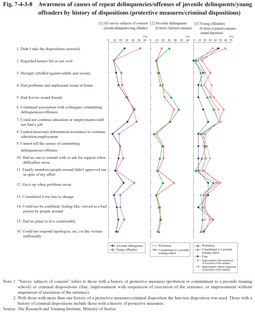5 Awareness of causes for repeat delinquencies/offenses
Fig. 7-4-3-8 shows the answers (by multiple choice method) of juvenile delinquents/young offenders with a history of protective measures (excluding those with a history of commitment to a children’s self-reliance support facility, etc. only) or criminal dispositions to the question of “what do you think were the causes that led to committing delinquencies or offenses after receiving the disposition.”
Juvenile delinquents (Fig. 7-4-3-8 [1]) selected “continued association with colleagues committing delinquencies/offenses (hereinafter referred to as “association with delinquents/offenders”)” (42.9%), “could not continue schoolwork or job/could not find a job (hereinafter referred to as “education/employment”)” (31.3%), “had few/no sound friends (hereinafter referred to as “sound friend”)” (29.8%), “not taking the dispositions seriously (hereinafter referred to as “neglecting dispositions”)” (26.6%), and “gave up when problems arose (hereinafter referred to as “giving up”)” (25.0%), etc. as the causes for repeat delinquencies, thus indicating that the problems of association with delinquent friends, education/work, limited relationships with sound friends, neglecting dispositions, and lack of motivation to solve problems were the major subjective risk factors in repeat delinquencies. Examining this by history of protective measures (Fig. 7-4-3-8 [2]) revealed that “association with delinquents/offenders” accounted for the largest in number with both those with a history of probation (45.0%) and those with a history of commitment to a juvenile training school (37.5%), thus indicating that association with delinquents/offenders was the most commonly recognized major risk factor. Following this, those who selected “giving up” (37.5%), “education/employment” (30.6%), “sound friend” (22.2%), “neglecting dispositions” (18.1%) were large in number with those with a history of commitment to a juvenile training school, and those who selected “sound friend” (32.8%), “education/employment” (31.7%), “neglecting dispositions” (30.0%), and “giving up” (20.0%) large in number with those with a history of probation.
Young offenders (Fig. 7-4-3-8 [1]) selected “neglecting dispositions” (52.1%), "education/employment” (46.1%), “giving up” (42.6%), “association with delinquents/offenders” (41.3%), “sound friend” (30.9%), and “had no place to live comfortably” (25.9%) as the causes for repeat delinquencies/offenses, thus indicating that the problems of neglecting dispositions, education/work, lack of motivation to solve problems, and association with delinquent friends were the major subjective risk factors, as with juvenile delinquents, along with unstable living bases. Examining the selection rate of the respective selectable items of young offenders by history of dispositions (Fig. 7-4-3-8 [3]) revealed that many young offenders with a history of protective measures selected the same items that juvenile delinquents did (“association with delinquents/offenders,” “neglecting dispositions,” “education/employment,” “giving up,” and “sound friend,” etc.). In contrast to this, however, the problems of association with delinquent friends and education/work were the subjective risk factors for over 40% of those with a history of criminal dispositions, regardless of the type of the last disposition but excluding fine. “Neglecting dispositions” accounted for nearly half of those with a history of fine/imprisonment with suspension of execution of the sentence, and “giving up” (47.5%) and “had no place to live comfortably” (37.7%) also were significant problems with those with a history of imprisonment without suspension of execution of the sentence.
In general, the problems of association with delinquent friends and education/work were the major subjective factors in repeat delinquencies/offences, regardless of being juvenile delinquents/young offenders. Predispositional problems, including neglecting dispositions and lack of motivation to solve problems, etc., were also significant. The selection rates of each of these problems were both generally higher with young offenders, with that of neglecting dispositions and lack of motivation to solve problems being particularly higher.
Examining the characteristics of awareness of the causes for repeat delinquencies/offenses of those with a history of commitment to a children’s self-reliance support facility, etc. (limited to those with a history of other dispositions; nine juvenile delinquents and 22 young offenders) revealed that the selection rate of “people around didn’t approved me in spite of my efforts” was higher at 33.3% with juvenile delinquents with the said history than with juvenile delinquents without the said history at 10.3%. In addition, with young offenders “giving up” (68.2% and 40.7% with those without the said history) accounted for the highest selection rate, followed by “education/employment” (63.6% and 44.7% (id.)) and “had no place to live comfortably” (50.0% and 24.1% (id.)), thus indicating that with young offenders with a history of commitment to a children’s self-reliance support facility, etc. the problems of lack of motivation to solve problems, education/work, and living bases were more significant.
Fig. 7-4-3-8 Awareness of causes of repeat delinquencies/offenses of juvenile delinquents/young offenders by history of dispositions (protective measures/criminal dispositions)
